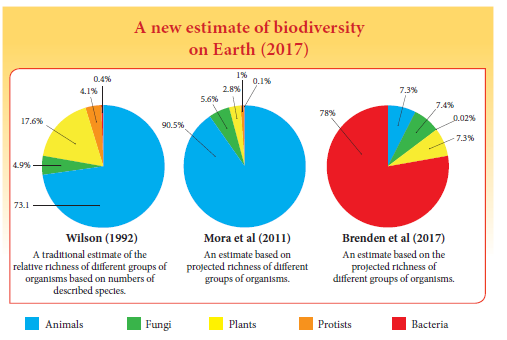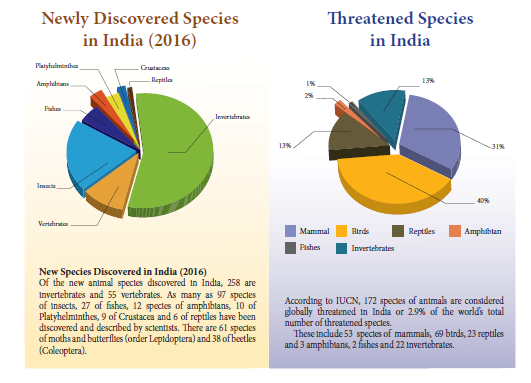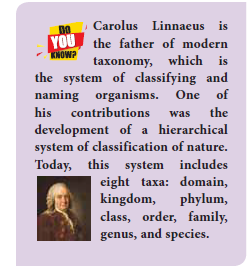Chapter Outline
1.1. Diversity in the Living world
1.2. Need for Classification
1.3. Taxonomy and Systematics
1.4. Three Domains of life
1.5. Taxonomic Hierarchy
1.6. Nomenclature
1.7. Concept of Species
1.8. Tools for study of taxonomy
Learning Objectives
1.1. Diversity in the Living world
1.2. Need for Classification
1.3. Taxonomy and Systematics
1.4. Three Domains of life
1.5. Taxonomic Hierarchy
1.6. Nomenclature
1.7. Concept of Species
1.8. Tools for study of Taxonomy
All living forms co-exist with each other. There are about 8.7 million species of animals which have been identified, named, described and classified. A study reports that 86% of all species on the land and 91% of those in the seas are yet to be discovered, described and catalogued. Though humans are placed in the top most position on the hierarchy, they have to depend on plants and animals for food. Animals are also used as source of labour, in farming, as pets, and for other economic benefits. Understanding animals and their unique characteristics, habitats, behaviour and evolutionary relationships is very important. This chapter deals with, diversity in the living world, need for classification, types of classification, taxonomical hierarchy, nomenclature and tools for studying taxonomy.
1.1 Diversity in the Living World
Earth has numerous habitats with a wide range of living organisms inhabiting them. Plants and animals are present in almost all of the places, from polar ice caps to volcanic hot springs, from shallow lagoons to the deepest oceans, from tropical rain forests to dry and parched


deserts. There are a variety of species that have been adapted successfully to live in diverse ecosystems. Ecosystem is a community of living organisms (plants and animals), non-living environment (including minerals, climate, soil, water,
sunlight) and their interrelationships (A.G. Tansley, 1935). The presence of a large number of species in a particular ecosystem is called ‘biological diversity’ or in short ‘ biodiversity’. The term
biodiversity was first introduced by Walter Rosen (1985), and defined by E.D. Wilson.
Difference between the Living and Non-living
Living organisms show a variety of unique characters different from non-living matter. The key characters of living organisms are,cellular organization, nutrition,respiration, metabolism, growth, response to stimuli, movement, reproduction,excretion, adaptation and homeostasis.Numerous scientists and taxonomists have made tremendous contribution and documentation in the observation and study of even minute characters in living organisms. Their keen observations have led to the classification of living organisms and the study of their interrelationships.
1.2. Need for classification
We come across many places where things are arranged in specific categories. In super markets, the shelves can have rows and columns of groceries, cosmetics, toys, stationeries, snacks and utensils.If it is not arranged in a well organized manner, customers and sales persons will waste lot of time in finding an item. In the same way, libraries also organize the books alphabetically or genres-wise into autobiographies, novels, kids stories, science fictions, etc. Likewise it is nearly impossible to study all the living organism hence it becomes necessary to device some means and methods to make this possible and this process is called classification. Classification is a process by which things are grouped in convenient categories,based on easily observable characters. The scientific term used for these categories is taxa (taxon–singular). Taxa indicates categories at different levels, for example Kingdom Animalia, includes multicellular animals such as reptiles, mammals, etc.Based on their characteristics, all living organisms can be classified into different taxa. This science of classification is called taxonomy. External and internal structures along with developmental processes and ecological information of organisms are essential, as they form basis of the taxonomical studies.Hence, characterisation, identification, nomenclature and classification are the scientific stages that are basic to taxonomy.
The basic need for classifications are:
• To identify and differentiate closely related species
• To know the variation among the species
• To understand the evolution of the species
• To create a phylogenetic tree among the different groups
• To conveniently study living organisms
1.3 Taxonomy and Systematics
Taxonomy (G. taxis- arrangement ; nomoslaw) is the science of arrangement of living organisms along with classification,description, identification, and naming of organisms which includes all flora and fauna including microorganisms of the world. The word taxonomy was coined by Augustin Pyramus de Candole (1813).Taxonomy is a theoretical study of classification with well defined principles,rules and procedures. Aristotle is called the father of taxonomy (classical) and Carolus Linnaeus is the father of modern taxonomy.
Systematics (G. System/sequence)
The objectives of taxonomy and systematics are very similar; their goal is to classify organisms with stipulated rules. The main criteria of systematics is identifying, describing, naming, arranging, preserving and documenting

the organisms. Apart from the above said features, evolutionary history of the species and the environmental adaptations and interrelationship between species are also being investigated in systematics.
History of Classification
Early classification of organisms were based on only two criteria, beneficial or harmful animals. An ancient classification system recognized 5 animal groups - domestic, wild, creeping, flying and sea animals. Initially the classification was based on organism’s fundamental characteristics such as the habitat and morphology only.
Aristotle (384 to 322 BC), was the first to classify all animals in his History of Animals (Historia Animalium in Latin).He attempted a basic classification of all living organisms into Plants and Animals.Animals were classified based on locomotion; walking (terrestrial), flying (aerial) and swimming (aquatic). Based on the presence or absence of red blood he classified the animals into two as Enaima with blood and those without blood as Anaima.
Aristotle’s classification system had limitations and many organisms were not fitting into his classification. For example, the tadpoles of frogs are born in water and have gills but when they metamorphosed into adult frogs they have lungs and can live both in water and on land. How to classify frogs and where to place them? Aristotle classified organisms based on locomotion, hence, birds, bats, and flying insects were grouped together just by observing one single characteristic feature, the flying ability. On the contrary to the above said example, the ostrich, emu and penguin are all birds but cannot fly. So Aristotle would not have classified them as birds.In spite of these limitations Aristotle’s classification system was followed for more than 2000 years upto 1700.

